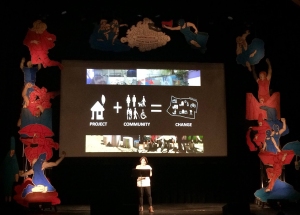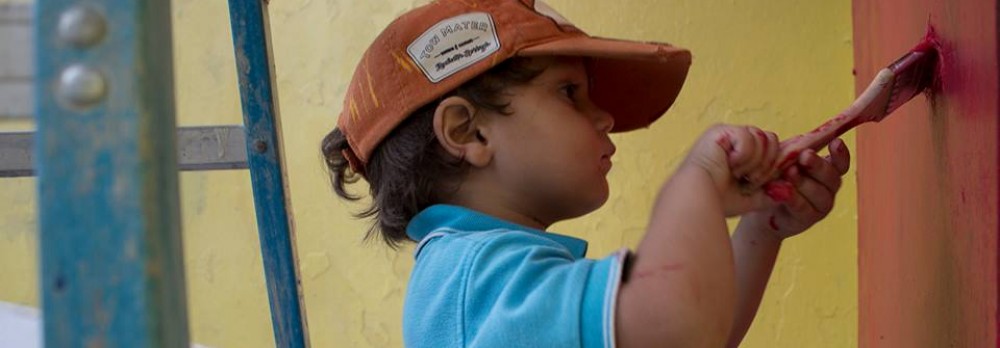
Since we are gathered here in order to think about ways to occupy the future, I came to tell you a story. The people behind today’s story are not trained artists or activists, but committed and hardworking people of different ages, shapes, colors and backgrounds. We had to train ourselves as professional squatters so I guess that’s the reason why we have been invited to this important meeting. The truth is that life will never be the same once you have the guts to defeat, in any way, our societies’ worship of the almighty notion of private property.
It all started with a bunch of seeds in the summer of 2013. An extraordinary woman planted a small edible garden in the front yard of an abandoned property. This was far from being the first attempt to prevent the undesirable consequences of having to coexist with a long standing “estorbo público” or public nuisance, but for some reason this time the soil was fertile for those seeds to grow. The small garden gave us a reason to get out of our houses and talk to one another. It also made us realize that we didn’t have a place to get together, where we could share our problems or concerns about our community. (It’s really scary honestly, to realize we can live in close proximity to one another but keep coming and going like perfect strangers…) So if this small garden had transformed our daily life in such a significant way, we asked ourselves: why could we not occupy the entire property? A few weeks later, we officially came out of the closet as squatters of Casa Taft 169. We did it in the hope that this would urge the municipality to take action, given the shameful amount of abandoned properties in the capital city of San Juan.
The property was a bricked up dumpsite so we went from this to this to this… And from this to this to this… And from this to this to this and this…
We also conducted some research because we knew the property had been abandoned for many decades. And we found out it had a huge municipal tax debt that actually exceeded several times the property’s market value. Moreover, the owner of the property died around 1973 and there were no legal heirs. We knew then that we were on the right track, otherwise the property would remain abandoned and would permanently be a huge headache for us.
From this point forward, everything we did and continue to do at Casa Taft 169 converges the past and the future. The signs of abandonment are highlighted and we challenge ourselves to find different ways to rebuild with whatever we have at hand. You can actually see traces of crawling plants and old peeling paint, which we framed in a shiny color. Also, we built a low cost green pavement made of concrete blocks and a wall made of reused bottles. Our commitment with this project is to denounce the problem of abandonment and simultaneously conceive and propose alternatives. This is very important because, under Puerto Rico’s outdated regulation, structures that are declared public nuisances are doomed to be demolished. We must prove that this properties are not merely disposable but great opportunities to upgrade our built environment under more sustainable criteria. Even more, we want to demonstrate there are people willing to and capable of transforming these spaces with very little investment, but a lot of work and creativity.
Our ultimate goal is to transform Casa Taft 169 into a unique co-created, bottom-up, self-run, self-sustained Civic Center, a place where locals and visitors can access services and engage in different activities. We also wish to endow the community of Machuchal (which is the historic name of the neighborhood where the project is located) with a much needed space to empower ourselves to work on improving the quality of life of all machuchaleros.
We envision our Civic Center as the epicenter of a broader transformation within our community. That is why we have also promoted other activities outside Casa Taft 169, specially at the local public school, which unfortunately became another abandoned property after the government decided to shut it down to “save money”. In other words, we wish to go from placemaking to capacity and community building.
Actually, we have gone from placemaking to policymaking, thanks to the extraordinary effort of one of our neighbors, who took on the challenge of unveiling the legal loopholes around abandoned properties without living owners or heirs. He also engaged a group of students and a local politician to draft a bill to amend our Civil Code to leverage partnerships between municipal governments and non for profit organizations willing to transform abandoned properties that have been declared public nuisances into new spaces of social impact.
A public campaign called todos somos herederos or “we are all heirs” was launched to take on the difficult task of reaching out to more people and organizations through social networks, networking, and the media. On the last minute, we even urged people to call the Governor of Puerto Rico to compel him to sign the bill.
And he did (just two and a half months ago) and we were very happy!
The new law grants the University of Puerto Rico a term of five-months to express interest on any property that has been officially declared as public nuisance, otherwise the property is transferred to the municipality, as a way to terminate any plausible debt by merger. Then, the municipality can grant, assign, sell, or rent the property to a non for profit organization.
But now, we have a bigger challenge. We need to identify these abandoned properties to match them with other people’s needs and ideas. To achieve this, Casa Taft 169 has partnered with La Maraña, a non profit dedicated to participatory urban design. Together, we have been compiling an inventory of public nuisances and we are also sharing our knowledge and tools so that other organizations can do the same.
We also wish to go a step further by marking public nuisances without living owners or heirs throughout the city to let people know where they are. But on the other hand, best practices and new policies must be developed, because the fact is there are no “abandoned” spaces. When we talk about a drug house or an unsanitary place we are actually talking about people; people that are homeless, people who feel, people who suffer, people who might be sick, people who might even have a job, but can’t pay rent. We now understand that these spaces are like mirrors reflecting our failure as a society to provide each and every human being with a decent life.
Finally, if we want the new law to become a true instrument of change we can’t give up on spreading the word, demanding action from the government officials, and encouraging others to join this movement as a different approach to address the imperative challenge of creating communities that are culturally rich, socially integrative, economically equitable, and environmentally sustainable.
When you realize that the debris from Casa Taft 169 can turn into a piece of art or can be recycled by La Maraña to transform an illegal dumpsite into a co-created wonderful public pocket park, you start believing that project by project, community by community we can create the changes we want to see in our island.
We live in a US territory under the so called PROMESA – the Puerto Rico Oversight, Management and Economic Stability Act- which threatens the wellbeing of the people living in our country in order to fulfill a public debt of more than 70 billion dollars. This is a perfect time to rethink the kind of society that we want to be. For example, a society that acknowledges the right to health, denied by the Federal government in 1952 when the puertorrican constitution was drafted.
As Eduardo Galeano once wrote, “utopia lies at the horizon.” We can never reach it, but it is useful to keep us walking…
Thank you!
